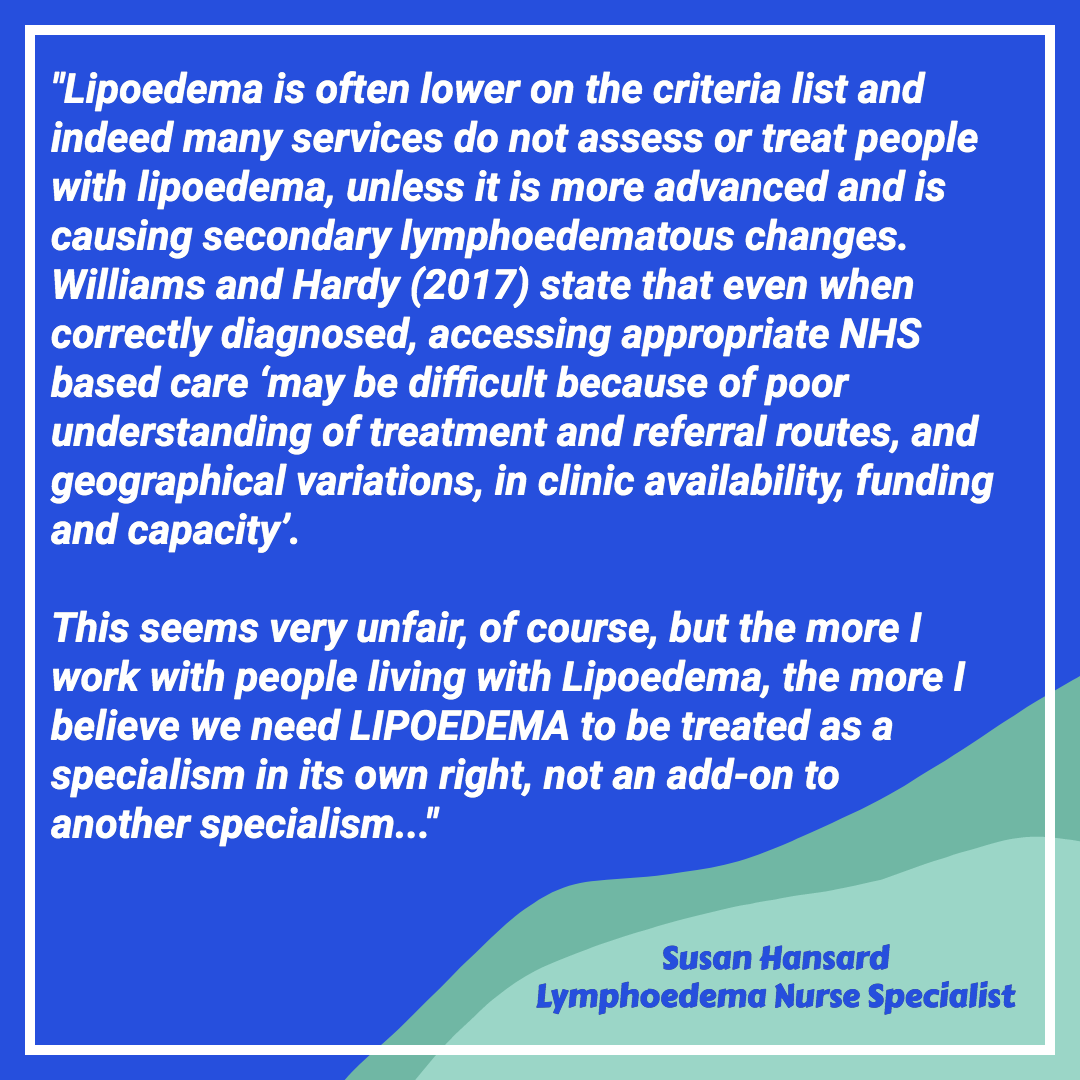LIPOEDEMA – Is it time for a re-think? By Sue Hansard, Lymphoedema Nurse Specialist
A personal opinion piece about working together, skilling up in specific knowledge and expertise and giving Lipoedema it's own dedicated specialist nurses.

"I have worked for 25 years in Lymphoedema Management, treating all types and causes of Lymphoedema but also treating Lipoedema. Over that time, Lipoedema and Lymphoedema are often seen as ‘counterparts’, ‘bed- fellows’, similar diseases. In the past, many Lymphoedema services included Lipoedema in their referral criteria - but this seems to be changing.
Lymphoedema services in the UK were already stretched before the covid pandemic took hold. Now 16 months on, some suspended services are beginning to see patients again face-to-face. Others are not yet able to re-open and some have closed permanently.
Many Lymphoedema Services in the UK are charity funded, often attached to Hospices, where the emphasis is primarily cancer care and end of life care. For some, Lymphoedema is not even mentioned in their Mission Statements. Other services are based in NHS hospitals, often as part of cancer care, with posts funded via Macmillan Cancer charity.
Lymphoedema does not always sit easily in these frameworks and even within these organisations, Lymphoedema Clinics may be regarded as a secondary service - they are certainly considered to be an expensive service.
So, when Lymphoedema Services need to decide their referral criteria they will need to consider the financial input, the team’s expertise and their capacity to treat.
For example:
- Cancer related oedema- secondary to cancer treatments only
- Non-cancer related oedema- primary lymphoedema (adults and or children)
- All causes- primary , secondary, venous disease, obesity.
- Lipoedema

And I wonder why are we not fighting for that?
Why isn’t the disease given a more correct and appropriate name, as opposed to a name which possibly does the disease no favours and which seems to cause more confusion than understanding?
Why are we not wanting that? What are we afraid of?
OVERVIEW
It seems to me that at least compared to Lymphoedema, Lipoedema is being under-served. It is treated as a less important disease than lymphoedema. The Cinderella of Cinderella’s.
In 2017, Wounds UK produced a collaborative document, ‘Best Practice Guidelines for the Management of Lipoedema’. It IS an excellent piece of work written by some of the UK’s most respected Lymphoedema experts who acknowledge that the condition is poorly diagnosed, poorly understood, poorly funded and not well researched. It states that LIPOEDEMA is ‘predominantly a chronic adipose tissue disorder’ where oedema (swelling) arises because of healthy lymphatic system overload rather than because of lymphatic damage or defect. (p4). Todd, (2010) and others suggest that tissue fluid build-up is a secondary feature of this multifactorial disease.
WHAT IS LIPOEDEMA?
LIPOEDEMA is a disease which affects subcutaneous adipose tissue or fatty tissue. The precise mechanisms are unknown, but likely to be multifactorial. (Okhovat and Alavi, 2014).
It is also considered to be a loose connective tissue disorder first described in 1940 by Allen and Hines. People with lipoedema may also exhibit joint hypermobility. It is possible that this may impact on contractility of lymph vessels, and on the effectiveness of the calf muscle pump.
There is a genetic predisposition to lipoedema, underscored by a family history in 15-60% of patients. (Child et al, 2010)
It predominantly affects women (although men can also suffer) from the age of puberty and beyond. There is a hormonal element to its development. It is characterised by symmetrical changes in size and shape of hips, buttocks and legs and occasionally the arms. Affected areas can be painful and bruise easily. Swelling does not affect the feet and is either non-pitting or only very mildly pitting with a negative stemmer’s sign. Swollen areas are disproportionate to the rest of the body. Skin remains supple. Weight loss and elevation do not reduce swelling.
Some argue that lipoedema is not primarily a disease of the lymphatics. That before onset and in the early stages of the disease, there is:
- No evidence of accumulation of lymph- negative stemmer’s sign
- No evidence of fluid accumulation- non-pitting
- No evidence of venous impairment - elevation does not reduce swelling
WHAT’S IN A NAME?
The more I read, the patients I treat, the more I ask the questions-
Is LIPOEDEMA the correct term to describe this disease?
What do we mean by the term?
What information are we conveying to those healthcare professionals we are keenly trying to educate?
Does the name move us forward in terms of gaining a groundswell of interest and funding for the research, and advancement of treatment and someday a cure?
Or is it holding us back?
DEFINITIONS
LIPO- means relating to fat or lipids
OEDEMA is a term which means: swelling caused by fluid accumulation in the tissues.
So, LIPOEDEMA means FAT (FLUID )SWELLING – which is inaccurate in the early stages at least.
Already we are muddying the waters!
In lipoedema, swelling is thought to be caused by a combination of:
- ADIPOCYTE HYPERTROPHY - fat cells themselves increase in size , rather than in number
- +/- HYPERPLASIA - increased number of fat cells
(Suga et al ,2009)
Other evidence shows that the rate of fat cell death increases and fat tissue becomes infiltrated by scavenger inflammatory cells (macrophages).
So, the physiological causes and the anatomical and pathological changes that occur in LIPOEDEMA are distinctly different to the mechanisms which cause LYMPHOEDEMA.
And while later stages of lipoedema may then also lead to lymphatic changes and lymphoedema, we are as yet uncertain whether this lymphatic failure is secondary in nature or whether there is pre-existing lymphatic impairment (Amann-Vesti et al, 2001)
There are several synonyms for lipoedema which adds to the confusion but maybe the term: ADIPOSE-CONNECTIVE TISSUE DISORDER (ACT) would be a more accurate term.
With a more accurate descriptor would it attract more interest from HCP’s, and research scientists?
Would it be possible to access more funding? Rather than relying on a proportion of funding for Lymphoedema?
Looking back over my 25 years in Lymphoedema management, I can see how much research now underpins all that we do in this specialist field. Research is taking place world-wide increasing our understanding of the lymphatic system and its embryonic and genetic development. Technology has been developed to help us diagnose, treat and manage Lymphoedema, including advances in surgical interventions and compression garments.
We hear less about developments into LIPOEDEMA.
We desperately need research into a multitude of unanswered questions about this life changing condition. We need to understand the pathophysiology, the genetic and hereditary influences, the precise mechanisms that eventually causes secondary lymphoedema.
LIPOEDEMA NURSE SPECIALIST? A NEW WAY FORWARD?
We now have Nurses, Physiotherapists, Occupational Therapists who are Lymphoedema Specialists. You can gain masters and degree level qualifications in Lymphoedema management. You can use your skills clinically or as an academic, as a Researcher or an educator.
So why not a LIPOEDEMA HEALTHCARE SPECIALIST?
While a multidisciplinary approach is often needed for this complex long-term condition, in the UK and in many other countries accessing treatment can be inconsistent, inequitable and fraught with stress and disappointments.
In the UK, patients are often referred to Lymphoedema services, but some services no longer treat Lipoedema. Others assess, prescribe hosiery and discharge, unless there is secondary lymphoedema which requires DLT prior to fitment of compression. If Lymphoedema services are not available patients may be referred to vascular or even plastic or bariatric services.
Despite this lack of an effective and comprehensive referral pathway the Expert Working Group of the Best Practice Document concluded that ‘Lymphoedema Services are the most appropriate setting for managing patients with lipoedema.’ ( W.UK. 2017,p16)
With respect: I disagree.
Yes, there are some services which have HCP’s who DO have a special interest and in-depth knowledge and understanding of Lipoedema, but it is wrong to assume that all services have the knowledge, interest, capacity to provide best practice in the principles of lipoedema management.
WHY DO I SAY THIS?
*Lack of understanding amongst Lymphoedema Therapists/HCP’s
I have worked in three different Lymphoedema services, all with different inclusion criteria based on the aims of the hospice to which they were attached. Funding was through charitable donations for end-of-life care. As such, sometimes Lymphoedema was excluded from their mission statements and by implication considered a lower priority for the organisations. Lipoedema was not referenced.
I have worked independently since 2003 and have treated many patients with Lipoedema, 90% of these had been initially assessed by a Lymphoedema service. At assessment, they were prescribed hosiery for daily wear, advised about skin care and discharged. They were not given instruction about Self Lymphatic Drainage massage, nor advised on exercise, or given psychosocial support. Some were given a Lipoedema UK leaflet. Most were told hosiery was the ‘mainstay of treatment’ but they might find MLD helpful (privately). All reported that they felt abandoned. And many found that they could not cope with the hosiery - until I had regained their confidence, taught them how to apply correctly, after which they tolerated it well.
* Training emphasis for most Lymphoedema therapists is almost exclusively is LYMPHOEDEMA
* Few services have clinicians with special interest and enhanced clinical knowledge and understanding of Lipoedema
- Many services only assess and advise hosiery
- Many services do not offer any physical treatment except DLT if secondary lymphoedema is present
- Many services do not provide (or make onward referrals to) orthotics, physiotherapists, psychological support, pain management, or weight management.
- Many Services just do not have the capacity to treat people with lipoedema as well as their lymphoedema caseloads.
So, I really do think that now is the time to re-think how we manage Adipose-Connective Tissue (ACT) disorder.
OUR PRIORITIES SHOULD BE:
1. Develop specialist ACT training courses for HCPs, Lymphoedema Therapists, GPs
2. Create ACT HCP Specialist role - to deliver Best Practice assessments and treatment planning and to facilitate education and awareness raising in primary and tertiary care sectors.
3. Raise profile of ACT, to increase interest and support, locally, nationally, governmentally and academically.
4. Maintain excellent relationship and work in tandem with Experts in Lymphoedema and professional bodies and the UK charities who do such excellent work in supporting those living with Lipoedema:
- British Lymphology Society
- International Lymphoedema Framework
- Lymphoedema Support Network
- All Training Schools in Lymphoedema management
- Lipoedema UK
- Talk Lipoedema
5. Foster links and working relationships with others working in ADIPOSE AND CONNECTIVE TISSUE disorders to create dialogue and exchange of knowledge and ideas.
LET’S START THE DEBATE
REFERENCES
Amann-Vesti et al 2001. Microlymphatic aneurysms in patients with lipoedema. Lymphology. 34(4). 170-175.
Child,A,H, et al. Lipoedema – an inherited condition. Am J Medical genetics Part A. 152A, 970- 796.
Fetzer. A, Fetzer S. 2015. Early lipoedema diagnosis and the RCGP e-learning course. Chronic Oedema 2015
Okhovat J.B Alavi, A. 2014. Lipoedema- a review of the literature, Int J Lower extremity wounds. 14(3).262-67.
Suga et al.2009. Adipose Tissue remodelling in lipedema: adipocyte death and concurrent regeneration. J Cutaneous pathology. 36.
Williams. A, Hardy, D. 2017. Developing best practice guidelines for the management of lipoedema. Best Practice Guideline: the management of lipoedema W.UK.BPG. P3.
BIBLIOGRAPHY
British Lymphology Society (BLS) What is lipoedema, Lymph Facts
Dayan, E, Kim. J. et al 2017 Lipedema, the disease they call fat: an overview for clinicians. Fetzer .A and Fetzer S. 2014. Lipoedema UK Big Survey Research Report
Fetzer . A and Wise.c. 2015 Living with lipoedema .Reviewing different self management techniques. B.J.Comm Nursing. Chronic Oedema Supplement. Oct. S 14-19.
Fife. C.E. et al. 2010. Lipoedema a frequently misdiagnosed and misunderstood fatty deposition syndrome. Adv Skin Wound Care 23 (2) 81-92.
Lisson, K. 2018. Lipedema Treatment guide. A Certified Lymphedema therapist’s advice for her clients with lipedema.
Lipoedema Uk : http://lipoedema.co.uk
Lipedema Foundation. (LF) Defining the lipedema research space. Www.lipedema.org
Lymphatic Education and Research Network (LE&RN)
SMH.LIPOEDEMA.MAY2021

